Sensor Sweep: Greynawk, Tanith Lee, Ron Cobb, Ahsoka
Monday , 25, September 2023 Sensor Sweep Leave a commentD&D (Grognardia): Longtime readers may object that I’ve already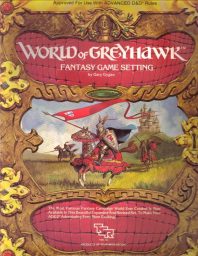 done a Retrospective post on The World of Greyhawk. Pedantic as ever, I must reply that, while it’s true that I have indeed written a post about The World of Greyhawk, I have never written one about World of Greyhawk. n 1980, TSR published The World of Greyhawk, a 32-page “fantasy world setting” by Gary Gygax for use with AD&D.
done a Retrospective post on The World of Greyhawk. Pedantic as ever, I must reply that, while it’s true that I have indeed written a post about The World of Greyhawk, I have never written one about World of Greyhawk. n 1980, TSR published The World of Greyhawk, a 32-page “fantasy world setting” by Gary Gygax for use with AD&D.
 Fantasy (Goodman Games): Poetic and prolific UK author Tanith Lee (1947-2015) ranged from the sun-dappled lands of fantasy to the mist-shrouded shores of horror, and seemingly everywhere in between. Spooky, sensual, and superbly-crafted, Lee’s genre-stretching work featuring vampires, doomed heroes, cursed lovers, gothic manors, crossed identities, unholy seductions, shapeshifters, demon princes, possession, sorcery, and madness was fantasy.
Fantasy (Goodman Games): Poetic and prolific UK author Tanith Lee (1947-2015) ranged from the sun-dappled lands of fantasy to the mist-shrouded shores of horror, and seemingly everywhere in between. Spooky, sensual, and superbly-crafted, Lee’s genre-stretching work featuring vampires, doomed heroes, cursed lovers, gothic manors, crossed identities, unholy seductions, shapeshifters, demon princes, possession, sorcery, and madness was fantasy.
Horror (Sprague de Camp Fan): What is cosmic horror? A superficial look at the sub-genre will show tentacled monsters lurking at the bottom of the deepest parts of the ocean and the crazed cultists that worship them. But further reading will show existential themes questioning free will and the significance of humanity. Spoiler alert: humanity, much less an individual human, isn’t significant at all.
sub-genre will show tentacled monsters lurking at the bottom of the deepest parts of the ocean and the crazed cultists that worship them. But further reading will show existential themes questioning free will and the significance of humanity. Spoiler alert: humanity, much less an individual human, isn’t significant at all.
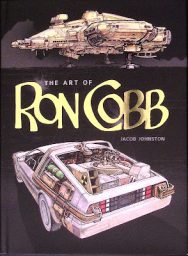 Art (Por Por Books): ‘The Art of Rob Cobb’ (208 pp.) was published by Titan Books in 2022. Like all the Titan titles it’s a well-made hardbound book, measuring 9 1/4 inches by 12 1/2 inches. Prior to the publication of ‘The Art of Ron Cobb’, the only book dealing with Cobb’s works was ‘Colorvision’, a 1981 trade paperback that, being long out of print, was very expensive. I was fortunate to pick up a copy back in the early 1980s.
Art (Por Por Books): ‘The Art of Rob Cobb’ (208 pp.) was published by Titan Books in 2022. Like all the Titan titles it’s a well-made hardbound book, measuring 9 1/4 inches by 12 1/2 inches. Prior to the publication of ‘The Art of Ron Cobb’, the only book dealing with Cobb’s works was ‘Colorvision’, a 1981 trade paperback that, being long out of print, was very expensive. I was fortunate to pick up a copy back in the early 1980s.
Pulp (M Porcius): Astounding, Feb ’42: Hubbard, Moore, Brackett, Jones &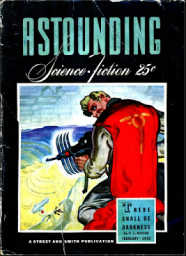 Sturgeon. Today we will be doing the same, and we are in for a treat, because “The Rebels” appears in an issue of Campbell seminal magazine full of work by writers of particularly high reputation and importance: Theodore Sturgeon, C. L. Moore, and Leigh Brackett. There’s also a piece by Raymond F. Jones, for whom I have a soft spot, so we’ve got five stories to deal with today. This might be a long one!
Sturgeon. Today we will be doing the same, and we are in for a treat, because “The Rebels” appears in an issue of Campbell seminal magazine full of work by writers of particularly high reputation and importance: Theodore Sturgeon, C. L. Moore, and Leigh Brackett. There’s also a piece by Raymond F. Jones, for whom I have a soft spot, so we’ve got five stories to deal with today. This might be a long one!
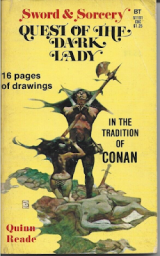 Fantasy (Paperback Warrior): I decided to read another vintage sword-and-sorcery novel, a Haas-penned paperback called Quest of the Dark Lady. It was written under the pseudonym Quinn Reade. The book was first published by Belmont in 1969 using artwork by Jeff Jones. It was printed again by Belmont using a different cover by Jeff Jones. The publisher re-cycled artwork that was first used on the Belmont paperback The Quest of Kadji by Lin Carter. The book was also published in the U.K. by Paramount using that same artwork.
Fantasy (Paperback Warrior): I decided to read another vintage sword-and-sorcery novel, a Haas-penned paperback called Quest of the Dark Lady. It was written under the pseudonym Quinn Reade. The book was first published by Belmont in 1969 using artwork by Jeff Jones. It was printed again by Belmont using a different cover by Jeff Jones. The publisher re-cycled artwork that was first used on the Belmont paperback The Quest of Kadji by Lin Carter. The book was also published in the U.K. by Paramount using that same artwork.
Crime Fiction (Vintage Pop Fictions): The Hunter, published in 1962, was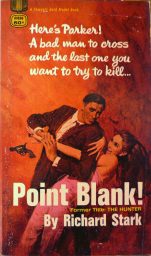 the first of the twenty-four noir novels featuring his anti-hero Parker written by Donald E. Westlake under the name Richard Stark. It was filmed in 1967 as Point Blank and subsequent printings of the novel carried the title Point Blank. I believe it has also appeared under the title Payback. For convenience I’ll refer to the novel as Point Blank.
the first of the twenty-four noir novels featuring his anti-hero Parker written by Donald E. Westlake under the name Richard Stark. It was filmed in 1967 as Point Blank and subsequent printings of the novel carried the title Point Blank. I believe it has also appeared under the title Payback. For convenience I’ll refer to the novel as Point Blank.
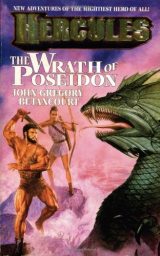 Fantasy (Dark Worlds Quarterly): A new series of Hercules tales in 1997 could only mean Tor Books was willing to gamble on the popularity of another Hercules. Kevin Sorbo had been starring in Hercules: The Legendary Journeys since 1995. Disney had their own Hercules in 1997. The public domain character of mythology was not owned by any one company. So Hercules fever gave us a new set of three novels. (Not to be confused with the novelizations from the TV show. These were written by Timothy Boggs and others.)
Fantasy (Dark Worlds Quarterly): A new series of Hercules tales in 1997 could only mean Tor Books was willing to gamble on the popularity of another Hercules. Kevin Sorbo had been starring in Hercules: The Legendary Journeys since 1995. Disney had their own Hercules in 1997. The public domain character of mythology was not owned by any one company. So Hercules fever gave us a new set of three novels. (Not to be confused with the novelizations from the TV show. These were written by Timothy Boggs and others.)
Popular Culture (Wasteland & Sky): This is quite interesting, because of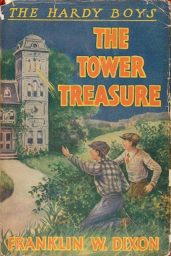 what the Hardy Boys actually were and what they became known as being are two radically different things. The original editions beginning to fall into the public domain is going to make those differences more well known because they will be the ones more readily available for the first time in nearly 100 years. Dover books, for instance, has already begun re-releasing the originals, and the differences are sometimes very jarring.
what the Hardy Boys actually were and what they became known as being are two radically different things. The original editions beginning to fall into the public domain is going to make those differences more well known because they will be the ones more readily available for the first time in nearly 100 years. Dover books, for instance, has already begun re-releasing the originals, and the differences are sometimes very jarring.
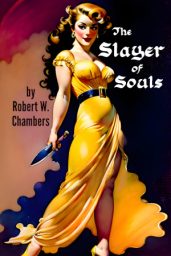 Fiction (Story Hack): Here is another free ebook. The Slayer of Souls by Robert W. Chambers. Link below. A girl is raised to adulthood somewhere in hidden Mongolia to be a psychic assassin. She escapes to America, where she is sure to be hunted by evil forces bent on spreading the horrors of communism. She meets a handsome government agent. He wants to protect her with his mad manly skills.
Fiction (Story Hack): Here is another free ebook. The Slayer of Souls by Robert W. Chambers. Link below. A girl is raised to adulthood somewhere in hidden Mongolia to be a psychic assassin. She escapes to America, where she is sure to be hunted by evil forces bent on spreading the horrors of communism. She meets a handsome government agent. He wants to protect her with his mad manly skills.
Weird Tales (Tellers of Weird Tales): Weird Tales for September 1923 contains 96 pages in its interior, sixteen stories in all, plus one credited essays and six uncredited nonfiction fillers, plus “The Eyrie” and “The Cauldron.” (The fillers are few enough in number that I will list them below.) The cover art was by R.M. Mally again, while the interior illustrations were all by William F. Heitman. There was a new main title logo in that September issue.
RPG (Jon Mollison): We made this dungeon on the fly using Appendix A of the greatest RPG book ever written, and it lasted for a solid three sessions of live play. We had parties of ten, then six, then nine delve this one and wring it for every last XP of value. It doesn’t provide near enough XP to level ten characters, but it makes for a good warm-up for a bigger prize.
RPG book ever written, and it lasted for a solid three sessions of live play. We had parties of ten, then six, then nine delve this one and wring it for every last XP of value. It doesn’t provide near enough XP to level ten characters, but it makes for a good warm-up for a bigger prize.
 Cinema (Bounding Into Comics): Financial analyst Valliant Renegade recently called for Marvel and Star Wars shows to be pulled from Disney+ after recently revealed Ahsoka viewership numbers show significantly declining viewership for Star Wars on the streaming platform.
Cinema (Bounding Into Comics): Financial analyst Valliant Renegade recently called for Marvel and Star Wars shows to be pulled from Disney+ after recently revealed Ahsoka viewership numbers show significantly declining viewership for Star Wars on the streaming platform.
T.V. (Wert Zone): The BBC has unveiled a new trailer for their upcoming trilogy of special episodes which will celebrate Doctor Who‘s 60th anniversary.
Pulp (Pulp Flakes): After a long series of articles on Black Mask, I felt the need for a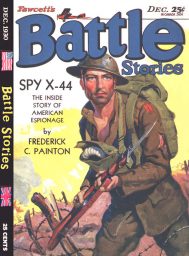 change. So here’s a review of a pulp title you don’t see that often: Fawcett’s Battle Stories. It was an attempt to cash in on the large and active group of American World War 1 veterans. These veterans had already banded together in the American Legion, which brought out a monthly magazine with a substantial dose of fiction.
change. So here’s a review of a pulp title you don’t see that often: Fawcett’s Battle Stories. It was an attempt to cash in on the large and active group of American World War 1 veterans. These veterans had already banded together in the American Legion, which brought out a monthly magazine with a substantial dose of fiction.
 Science Fiction (Black Gate): The Big Book of Cyberpunk is a feast of a book, 1136 pages of fiction from the biggest names in science fiction. It belongs on your shelf next to the most monumental and groundbreaking anthologies of the last few years, including Jeff and Ann Vandermeer’s Big Book of Science Fiction, The Weird, and Lawrence Ellsworth’s Big Book of Swashbuckling Adventure.
Science Fiction (Black Gate): The Big Book of Cyberpunk is a feast of a book, 1136 pages of fiction from the biggest names in science fiction. It belongs on your shelf next to the most monumental and groundbreaking anthologies of the last few years, including Jeff and Ann Vandermeer’s Big Book of Science Fiction, The Weird, and Lawrence Ellsworth’s Big Book of Swashbuckling Adventure.
H. P. Lovecraft (Tentaclii): Assembled from the best pictures on various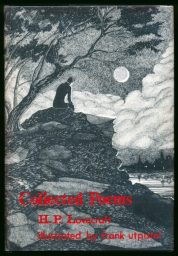 listings, here’s a closer look at the fine detail and penmanship of the pleasing Frank Utpatel cover for the Arkham Press edition of Lovecraft’s Collected Poems (1963).
listings, here’s a closer look at the fine detail and penmanship of the pleasing Frank Utpatel cover for the Arkham Press edition of Lovecraft’s Collected Poems (1963).
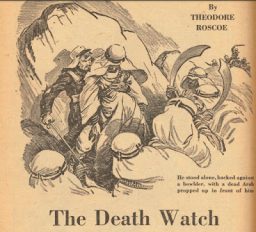 Pulp (Comics Radio): A couple of months ago, I reviewed one of J.D. Newsom’s excellent Foreign Legion stories. That particular story had been published in the October 1940 issue of Foriegn Legion Adventures. I’ve been periodically reading through the other stories in that issue and ran across yet another really good one.
Pulp (Comics Radio): A couple of months ago, I reviewed one of J.D. Newsom’s excellent Foreign Legion stories. That particular story had been published in the October 1940 issue of Foriegn Legion Adventures. I’ve been periodically reading through the other stories in that issue and ran across yet another really good one.
Fiction (Cyborg Caveman): What a great little book! One of several DAW paperbacks I found at a used book store in Jax, FL, One Against A Wilderness is a true gem. It would be easy to dismiss this as Tarzan in Alaska, the same way Jongor is Tarzan in Australia, but Kioga distinguishes itself lots of in little ways. Elements of Burroughs’s Tarzan, Kipling’s Mowgli, and Native American culture
paperbacks I found at a used book store in Jax, FL, One Against A Wilderness is a true gem. It would be easy to dismiss this as Tarzan in Alaska, the same way Jongor is Tarzan in Australia, but Kioga distinguishes itself lots of in little ways. Elements of Burroughs’s Tarzan, Kipling’s Mowgli, and Native American culture
Fantasy (Mostly Old Books and Rust): Gardner Fox was amazingly prolific, writing thousands of comic books, plus a slew of novels and short stories. During the Sword and Sorcery revival in the 1960s, arguably triggered by Lancer republishing Robert E Howard’s Conan pulp stories, Fox wrote these Kothar Barbarian Swordsman stories. Sure, they’re directive as hell, and would have fit right in with Weird Tales in the 1930s, although that’s no reason to be dismissive.
Please give us your valuable comment